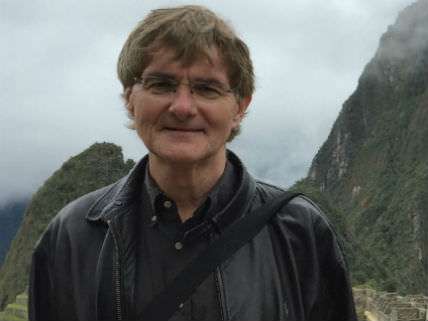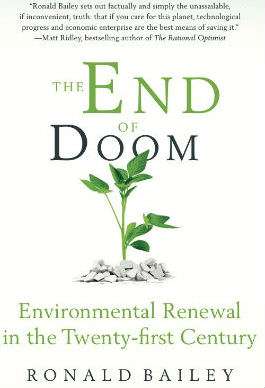Against the Dogmatists, a Review of The End of Doom
Modest self-promotion of my new book

As a service (self serving?) for Reason readers I am cross-posting this review of my book, The End of Doom: Environmental Renewal in the Twenty-first Century (St. Martin's Press) here from RealClearBooks.
Against the Dogmatists
Environmentalist doom-saying, according to author Ronald Bailey, is not about scientific prediction but about ideology: one that says nature is good and humanity is evil. In The End of Doom, Bailey challenges modern environmentalism on its own ground. Cut loose from its scientific moorings, environmentalism attacks the human aspiration for a better life. Doing so, at the very least, it holds back the positive economic and social developments that, over the course of this century, will see nature become chiefly an arena for human pleasure and less a source of raw materials.
Environmentalists have long targeted globalization, which they see as destructive of local cultures and local habitats. As Bailey shows, they have it completely wrong. The emancipation of women, along with increased life expectancy, leads women to have fewer children, especially in wealthier societies. Bailey has a gift for letting the anecdotal illustrate the trend. A Johannesburg taxi driver remonstrates with Bailey for not having children and tells him that whereas his father had 12 children, he has six—but his children have none. Eureka. This is the demographic transition which, Bailey suggests, will see the world's population peak at 9.6 billion in 50 years' time and gently decline to 9 billion by the end of the century.
Capitalism and the rule of law are the key drivers of this development, and those countries most open to trade have seen the fastest decline in fertility rates. By contrast, the lawlessness, violence, and economic chaos of many countries in sub-Saharan Africa result in stubbornly high fertility rates. This state of affairs turns conventional environmentalist nostrums on their head. For example, in one of the most cited papers on ecology, "The Tragedy of the Commons," biologist Garrett Hardin asserted in 1968 that human over-population would necessitate replacing Adam Smith's invisible hand with government coercion. But Hardin was theorizing without facts. "Hardin's fears of a population tragedy of the commons are actually realized when the invisible hand of economic freedom is shackled," Bailey writes.

One after another, Bailey neatly picks off each "peak everything" fear. Even though commodity prices are now coming off the top of a super-cycle, since 1871, the Economist industrial commodity price index has sunk to around half its value. Thanks to improved energy productivity, in 2007, the U.S. consumed half the energy it would have if energy productivity had remained at its 1970 level. Technology will continue to make more efficient use of resources. 3D printing could reduce materials needs and cost by up to 90 percent.
Bailey makes the crucial distinction between scarcity and shortage. Scarcity exists because human wants are boundless while the resources to satisfy them are limited. Shortages arise when something is not available at any price and when governments intervene to stop markets working properly. According to a survey on water access in major cities in the developing world, poor people pay a multiple of what those connected to the water mains do. How to improve water access for the world's poor? Privatization. Only 3 percent of the poor in developing countries get their water from private-sector water suppliers, yet even this miniscule percentage has provoked an outcry against a "global water grab" by giant corporations. Bailey notes that the Intergovernmental Panel on Climate Change (IPCC) is silent on the role of markets and prices in managing water scarcity.
The End of Doom marshals findings from a prodigious survey of scientific papers and other scholarly papers – about 220, by my count, or four for every five pages. But more often than not, Bailey himself provides the most thought-provoking ideas. "Resources are defined by human knowledge and technology," he writes, which helps explain the fall in commodity prices. "Never do anything for the first time" says all you need to know about the precautionary principle. "History provides us with no models of sustainable development other than democratic capitalism" deftly skewers the 1987 UN Brundtland report and Pope Francis's recent musings.
Bailey brands Rachel Carson's cancer chapter in Silent Spring a "stroke of public relations genius," and he condemns the Nixon administration's "political" ban on DDT for taking away the most effective way to control malarial mosquitoes. Carson's unwillingness to fairly balance costs and benefits became the hallmark of the modern environmental movement, which today is busy attacking genetically engineered Golden Rice—even as Vitamin A deficiency causes 1.9 to 2.8 million preventable deaths each year and half a million cases of childhood blindness. As Bailey notes, "environmentalist organizations raise money to support themselves by scaring people."
Once a climate skeptic, Bailey now sees the balance of evidence pointing to the likelihood that rising temperatures would become a problem by the end of the century. It would be hard to find a more evenly balanced account of the scientific uncertainties of global warming. The prolonged pause or plateau in global temperature is "something of an embarrassment," Bailey writes, and he quotes a climate scientist cautioning against extrapolating long-term trends from it; but the scientist also concedes that "the inconsistencies we found among the models are a reality check showing we may not know as much as we thought we did."
The best is saved for last, when Bailey provides a cool antidote to the emotional journey Elizabeth Kolbert took in The Sixth Extinction. With certain exceptions, the IPCC finds "very low" extinction rates during the last several hundred thousand years of climate change. It is a matter of faith, not science, that pristine ecosystems are superior to human-influenced eco-systems. Science, long a tool of environmentalist dogmatists, now shows the ecological notion of the "balance of nature" to be unscientific. In an often high-decibel debate, Bailey's prose is soft-toned and reasonable. His is a voice that compels attention—and The End of Doom a book that provokes fresh thinking.
Rupert Darwall is the author of The Age of Global Warming: A History (Quartet, 2013).
I will post additional reviews and some responses later.

Show Comments (35)